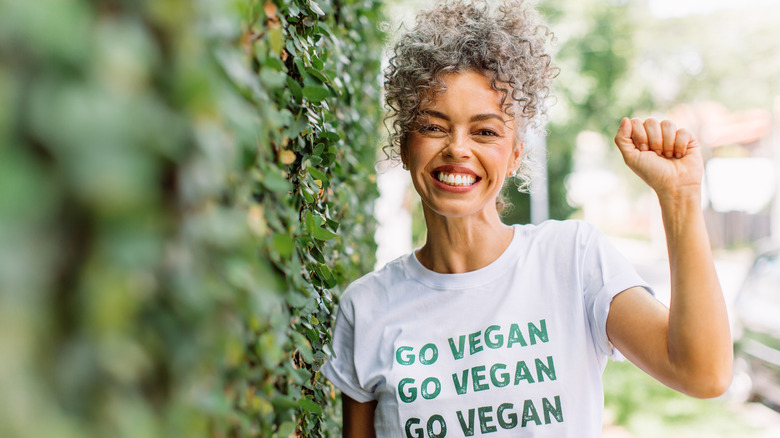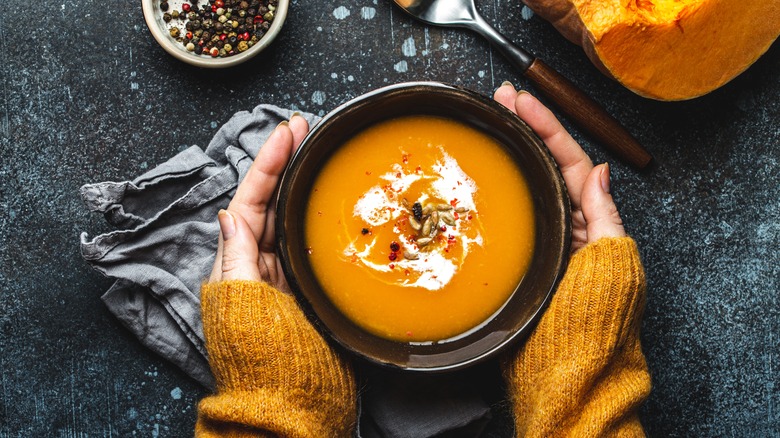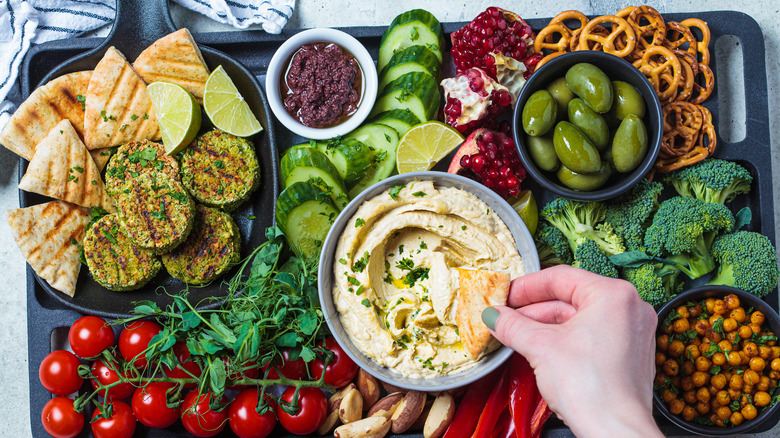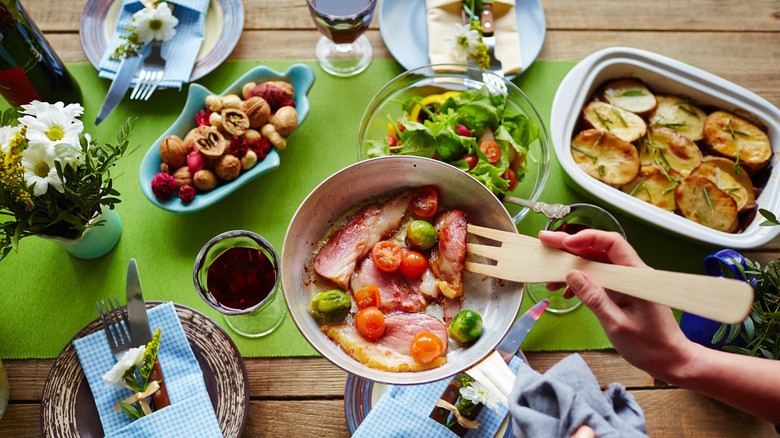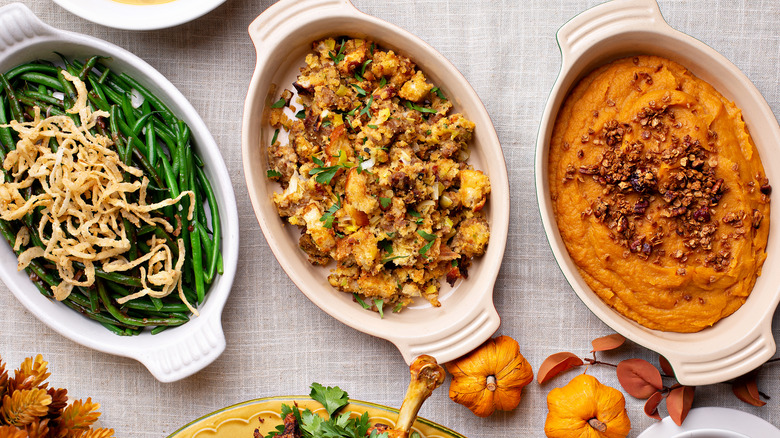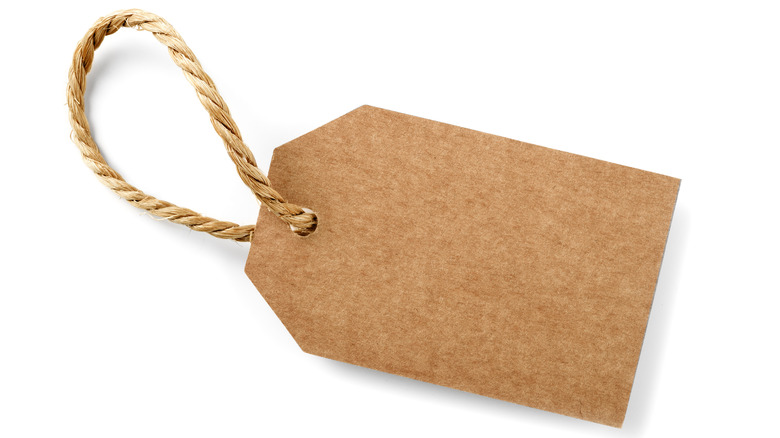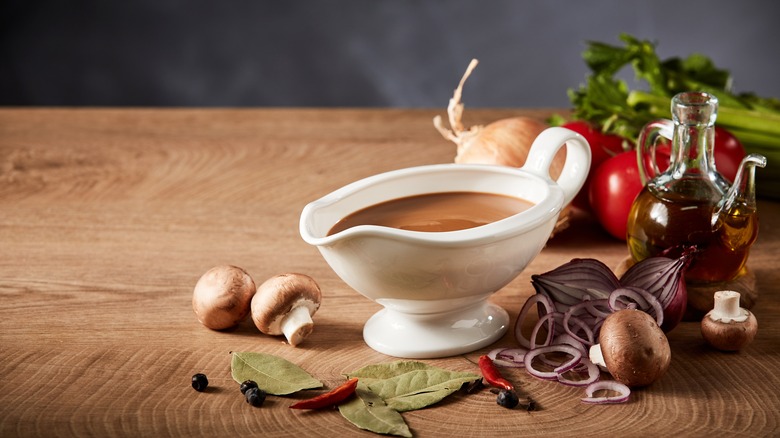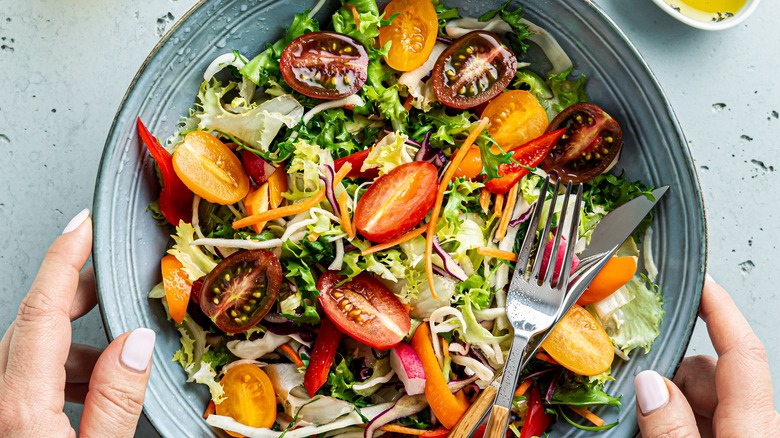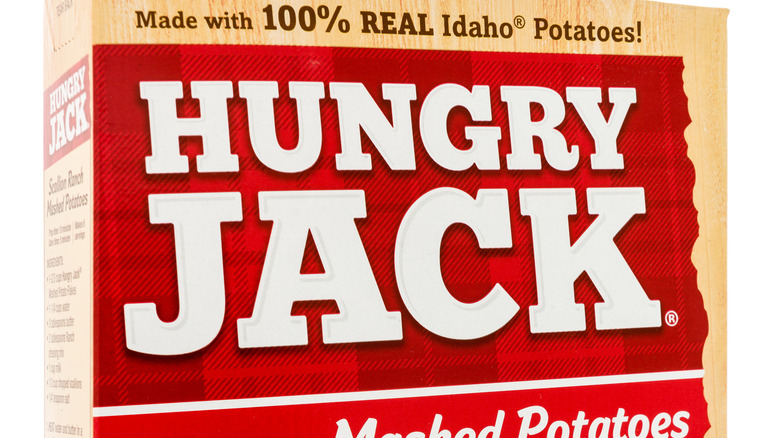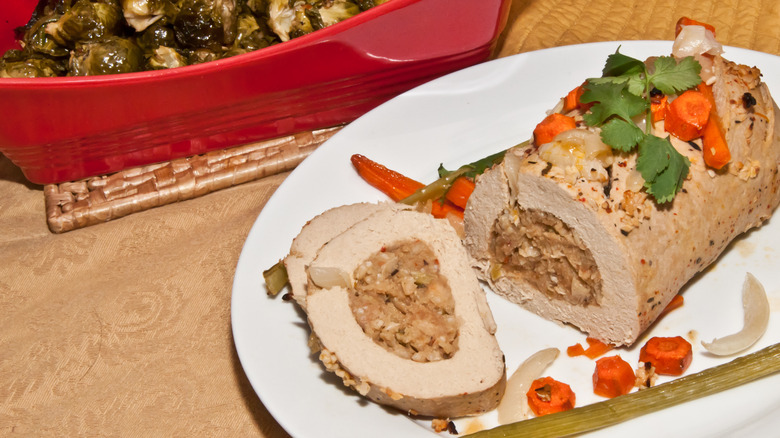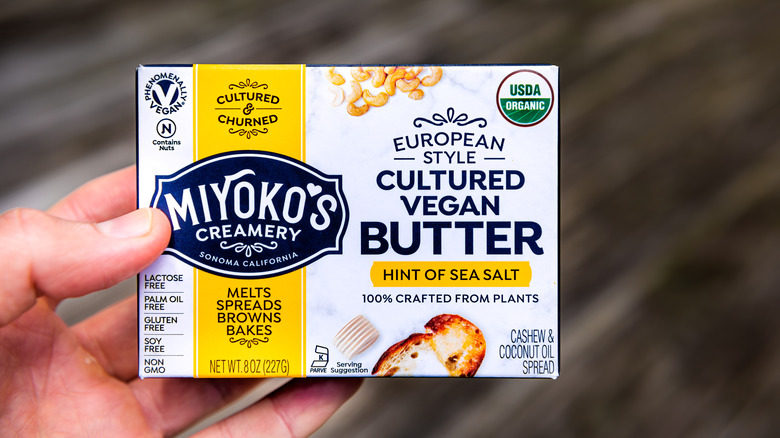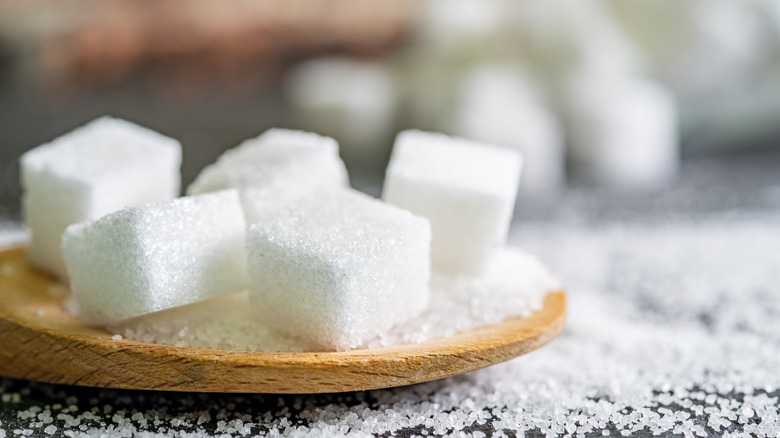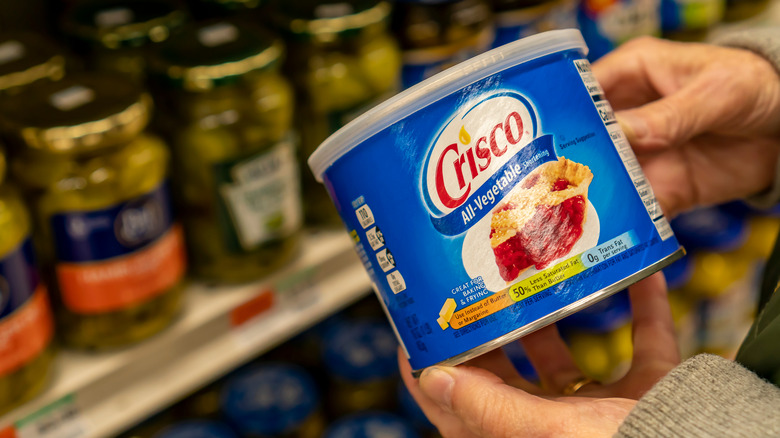15 Tips For A Vegan-Friendly Thanksgiving Feast
We may receive a commission on purchases made from links.
Thanksgiving is a day that many vegans don't want to talk about. Although the table is set with bountiful options of cranberry sauce, mashed potatoes, and of course the dreaded turkey carcass, many vegans resort to bringing their own food to Thanksgiving or politely taking a dinner roll and explaining to friends and families that they're just not hungry.
While no one should expect you, a host, to cater to any particular type of dietary choice over another, there are a plethora of options out there for reducing the amount of animal-based products you're using this Thanksgiving. In many cases, you also might be indirectly helping folks with dairy or egg allergies to have a seat at your Thanksgiving table, too.
Here are some ways that you can vegan-ize your Thanksgiving this year (or at the minimum, make it more vegan). Plus, many of these tips and tricks do not dramatically alter your Thanksgiving budget or the palates of the meat-eaters at your table.
Familiarize yourself with what constitutes vegan
No, vegetarian and vegan are not the same thing.
Even if you have one vegan coming to your Thanksgiving in a crowd of 60 meat-eaters, you should have some basic idea of what that person eats or abstains from eating. As a whole, The Vegan Society notes that vegans abstain from the consumption of animal products, as well as the exploitation of animals through things like zoos and racetracks. Despite this broad definition, not all vegans are on the same page. Some are more observant (or militant — whatever you prefer to term these types of eaters), and those vegans will abstain from eating food cooked on the same surface as meat. Other vegans might call themselves vegan but actually indulge in a cheese pizza once or twice when the mood strikes. The clearer you can be about what you need to do to support the diverse eaters attending your Thanksgiving, the more it will pay off in the long run.
Start your meal with a dairy-free soup
Soup is a great way to celebrate autumnal flavors while pre-gaming the rest of your Thanksgiving meal. Plus, there are many filling dairy-free and vegan recipes out there that will leave your Thanksgiving guests excited for the next course. We recommend making a creamy pumpkin soup for your Thanksgiving this year; the best part is that this soup is ready-to-eat in less than 30 minutes! Simply combine canned pumpkin puree, beans (for depth and protein), miso paste (for umami), coconut milk, and warming spices in a stock-pot or Dutch oven. Once the soup is cooked through, use a handheld immersion blender to pulse the soup until thick and smooth. You can choose to serve pumpkin soup with an optional side half-and-half if folks at your table prefer a creamier option. Most guests at your table won't realize that this soup is vegan because of how creamy the coconut milk is on its own.
Include dairy-free cheese on your charcuterie board
Dairy-free cheeses have surged in popularity in recent years because of their resemblance to the flavor and texture of regular, dairy-based cheeses. Brands like Miyoko's Creamery craft its cheese from soaked raw cashews and flavored with cultures, seasonings, and alike. Miyoko's dairy-free cheeses come in a diversity of flavors like smoked gouda, sharp English farmhouse cheddar, and sun-dried tomato garlic.
Besides dairy-free cheeses, you can include other plant-based spreads, crackers, nuts, and seeds on your charcuterie board. Hummus is always a popular spread and can be altered with the addition of simple ingredients like roasted beets or pumpkin seeds. If you choose to serve foods with potential allergens (including the aforementioned cashew cheese), we recommend purchasing small dishes to serve on the table rather than allowing the ingredients to touch on the same board. The perfect charcuterie board contains snack crackers, as well; we recommend stocking up on woven crackers and pretzel thins.
Serve vegan wine and beer
Alcohol isn't vegan? While at the surface all alcohol appears vegan, the Minimalist Vegan notes that many companies still use gelatin, egg whites, isinglass (fish bladder), or animal-based filters to process their beverages. Hard liquor, the Minimalist Vegan notes, is always vegan — except for cream-based liqueurs.
If you're responsible for purchasing alcohol for Thanksgiving dinner, try to consult the label before you purchase a bottle. According to Vegan.com, popular vegan beer brands include Budweiser, Coors, Miller-Lite, and Pabst Blue Ribbon. Charles Shaw's red wine and Yellowtail red wine are two common brands you'll find in most liquor stores that are certified vegan.
If you're looking to support a more niche vegan alcohol brand, we recommend trying The Vegan Vine. This brand is owned by retired basketball player John Salley and the Murphy family of Northern California. The goal of Vegan Vine is to promote great-tasting chardonnay and cabernet sauvignon while sustaining healthy, productive, vegan-friendly viticulture practices.
Use designated serving and preparation utensils to prevent cross-contamination
Using designated serving utensils for any event is just good practice, but it's especially important when we think about dietary restrictions and allergies. To ensure everyone at your table has a safe, healthy holiday together, you should make sure to keep the utensils separate and avoid cross-contamination.
Avoiding cross-contamination in the kitchen starts in the prep stage. If you're slicing ready-to-eat produce for a salad, it should come nowhere near the gizzards being chopped up. Whether you realize it or not, the meat products you cut on a cutting board emit juices that can either make others sick. You should not use the same cutting board for meat products as you do vegetables. If you only have one cutting board in the kitchen, wash the board with warm, soapy water and air-dried it or pat it with paper towels. Plastic, acrylic, or wood cutting boards can also be placed in the dishwasher for optimal sanitization.
When it comes to serving, keep a serving utensil in each dish rather than allowing guests to use their own forks or spoons to serve themselves. And when in doubt, wash the utensil to prevent cross-contamination.
Ask your guests to provide side-dishes
If you're the go-to person to cook and host everything on Thanksgiving, you know how stressful timing is when to put the stuffing in the oven with three other items waiting in the oven queue. Why not just outsource your side dishes to your guests?
Asking each of your guests to bring a side dish to Thanksgiving is a gentle way to ask folks to prepare dishes they would like to eat. If you're rushing to start a vegan dish you've never made in your life (let alone eaten), you are setting yourself up for failure. Plus, all of the guests will have at least one "safe food" at the gathering to fit their dietary preferences. If you go this route, you're bound to have folks prepare a wide range of dishes that other folks can taste, and possibly ask for a recipe from another guest. If your Thanksgiving guests tend to be a quiet crowd, the food individuals brought over is bound to start a conversation.
Label your dishes for potential allergens
Labeling your dishes for food safety is one of the most considerate and practical things you can do at your Thanksgiving dinner— especially when you don't have the time to answer the dreaded "what is that?" over and over again. When writing out a food label, use "vegan" or "vegetarian" in addition to "gluten-free" or "contains x allergen." This will ensure that your guests have an informed experience when picking out what to add to the plate.
If you're hosting a big Thanksgiving, you can go classic with mini-chalkboards (and re-use the boards year after year or for other events) or stick to a rustic paper label. For those folks not looking to spend a big chunk of money on tags, consider using a sheet of butcher paper on the table and writing your labels with a marker. Plus, the paper doubles as a cheap tablecloth that will still give your Thanksgiving celebration an A+ on aesthetics.
Substitute vegetable broth in stuffing recipes
One of the simplest plant-based switches you can make in your kitchen involves broth and stock. The broth is the primary ingredient that binds the Thanksgiving stuffing together, and it, along with butter and eggs, makes your stuffing not vegan. Substituting vegetable stock for poultry stock on Thanksgiving will produce a similar flavor without too much work involved.
If you don't have a box of vegetable broth or stock handy, consider purchasing a concentrated form of broth on hand whenever you need it. Our favorite brands include Better Than Bullion, which can be reconstituted for 8 ounces (1 cup) of broth with a teaspoon of concentrate. You can also make your own vegetable stock and customize it based on whatever is in your produce drawer. Adding mushrooms present a new umami flavor that makes the stock much more pronounced in a vegan gravy or vegan stuffing.
Prepare a salad with plant-based protein and fat
Salads don't always have to be just boring lettuce and chopped veggies. If you're hesitant to deviate from the traditional "meat-and-potatoes" Thanksgiving to adopt Tofurky, you first may want to reconsider your salad. The salad has the potential to feature proteins, fats, fresh veggies, and tons of flavor — so much so that it might satisfy the vegans at your table looking for a filling option.
Our favorite protein options for salads have to start with beans. Sprinkling crispy roasted chickpeas on your salad can add a customized flavorful and colorful boost. Your guests will appreciate it if you try to make your own vinaigrette with Dijon mustard, garlic, olive oil, and vinegar; you can also add a plant-based sweetener like maple syrup or agave to counteract the acid in the dressing. Other proteins and fat options to serve with your salad include steamed five-salt edamame or roasted almonds seasoned with crispy herbs.
Let pre-packaged foods make your job easier
You might be convinced you can master vegan mushroom gravy, homemade mashed potatoes, and vegan-ized green-bean casserole in a matter of hours. But, pre-packaged food will always be your friend when it comes to big culinary gatherings.
If you need a vegan side dish, pre-made, consider purchasing a box of Annie's vegan cheddar flavor mac. Dress your pasta up with a bit of homemade baked breadcrumbs or the addition of broccoli and pop it on the table. Road's End gravy packets are vegan, and organic, and come together in a matter of minutes. And for stuffing, we're going to stick with a classic Pepperidge Farm herbed-seasoned stuffing that may not deviate from the bagged stuffing you've been buying since the dawn of time anyways. If you're looking for another simple side idea that comes together in a matter of minutes, look to your fresh vegetables. Steam carrots and serve with organic brown sugar and vegan butter or add fresh green beans to a pot with garlic and cook until fragrant.
Consider offering a meat alternative for the main-dish
Meat alternatives on Thanksgiving? Your mind might already to go Tofurky. Seth Tibbott started Tofurky as a partnership between a tofu roast and a wild rice stuffing. Since 1978, Tofurky expanded to include a vegan ham roast made with seitan and tofu and a spin on the traditional roast served with gravy and a brownie. Like its avian counterpart, Tofurky can be prepared in the oven.
While proponents of Tofurky have applauded its flavor and effort to resemble an actual turkey roast, we should note that its flavor is not for everyone. If you're looking for vegan alternatives to serve on Thanksgiving, you can look to other plant-based meat brands like Gardein and Quorn. Be advised that whatever meat alternative you serve on Thanksgiving will likely not be as popular as the traditional turkey roast, so it's best to survey your audience first to see who would actually eat the alternatives you offer.
Use plant-based butter for mashed potatoes and rolls
Vegan bakers swear by plant-based butter because of its resemblance and texture to dairy-based butter. Having a stick of plant-based butter on-hand during your Thanksgiving is the key to creamy vegan mashed potatoes and as an accompaniment to freshly baked dinner rolls. You can purchase plant-based butter sticks at your local grocery store with the other dairy-based butter, although some stores tend to hide the butter alongside other plant-based products.
Our favorite brands for vegan butter include Country Crock and Miyoko's. You can purchase Country Crock Plant-Butter with either an avocado oil or an olive oil base (we have found no difference in the texture or flavor of the two). The butter sticks are more practical than the spread because the sticks can be converted into measurements more easily than the spread can. Other brands like Trader Joe's have made spin-offs of vegan butter as well.
Use organic sugar in your pies and baked goods
Wait, sugar isn't vegan, either? Make It Dairy Free notes that there are three main types of sugar in conventional food manufacturing: sugarcane, beet sugar, and coconut sugar. In order to make sugarcane white, processors may use bone char as a whitening agent. Vegan bakers, as a result, will substitute white, granulated sugar with either organic sugarcane or other, non-sugarcane options.
If you're baking vegan pies or desserts for Thanksgiving, you will need to substitute the sugar in these recipes for a vegan alternative. If you want to stay away from granulated sugar altogether, you can use a liquid, plant-based sweetener like maple syrup or agave. The Vermont Maple Sugar Makers Association notes that using maple syrup, or any liquid sweetener, in baking may alter the ratio of other liquids. You can add a bit of baking soda to your recipe to lighten up the viscosity of the syrup, as well.
Substitute plant-based ingredients in your pie recipe
The hallmark of the perfect pie is a good crust. But how can you make a delectable, flakey crust that is vegan? One of our favorite ways to make vegan pies with the same fall-apart crust as a traditional butter version is to substitute vegetable shortening. Although shortening contains a lower water content than butter (thus resulting in less puff), the fat content will produce a similar flake to a butter crust.
When it comes to fillings, there are tons of plant-based fruit options that you are bound to find on a Thanksgiving dessert table anyways. Apple pie and cherry pie require very little alteration to be made vegan, while cream-based pies like chocolate and pumpkin require a bit more effort. If you need to substitute for dairy-based creams, you should resort to coconut milk and coconut cream because of the high-fat content and mild flavor.
Don't be afraid to deviate from the normal Thanksgiving meal
Does every Thanksgiving have to include the standard fixings like turkey, mashed potatoes, stuffing, and pumpkin pie? Of course not!
When it comes to Thanksgiving dinner, try to be creative — even if it means deviating from the traditional menu. If you serve boxed pasta with marinara sauce (which is vegan by nature) with an accompanying plate of meatballs (that can be made vegan or with beef) for Thanksgiving this year, who cares? Or, consider ordering takeout and having dinner with loved ones in front of a great rom-com movie. Thanksgiving, at its core, is about being thankful for the folks we get to have at our dinner table and the memories we get to share with one another. It shouldn't really matter what's on the table, but the more we are able to accommodate diverse diets, the more seats at the table we will find ourselves with.

